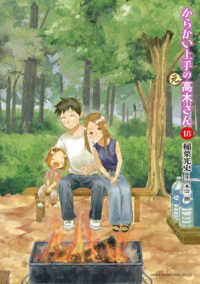- ホーム
- > 洋書
- > 英文書
- > Architecture
Full Description
Explanations for what makes one landscape scene preferred over another - formalistic, cultural and ecological - continue to be generated by landscape architects and land managers, philosophers and psychologists.This is needed for planning in the countryside and the protection of natural scenery, yet agreement still eludes us. This book does not favour any particular theory, but critiques the many theories seen over the last half-century. It informs readers of the main lines of argument so that they can make up their own minds. Part one, on post-war aesthetics, examines ideas about the unconscious, holism, overarching 'metanarratives', and the search for objectivity. Part two describes the consequences on the 'cultural turn' in that period, giving rise to new theories taking the human as reference. Cultural geography, cultural landscapes, changes in methods of assessment and some new ideas on landscape design are set in this context. Ecocentrism proposed a very different approach. The final part looks into the philosophical input, expanding upon 'environmental aesthetics'. It concludes with a more down-to-earth analysis of 'satisfactions' from immediate formal qualities, the sublime, meanings, and beauty. The balanced, didactic approach taken will make this a standard text for all those in teaching and in landscape practice.
Contents
Part A: THE UNFATHOMABLE WORKINGS OF THE UNIVERSE: 1. Art into landscape - The problem with functionalism, Landscape among the fine arts, Ideas into form, The laws of the universe, Unconscious expression; 2. Landscape beauty - The English countryside, The selection of the British National Parks, The search for objectivity, Formal qualities; 3. Natural instincts - Environmental determinism, Unity with nature, People and the land, The imperative of climate and soil, The ethics of the land, New Landscapes, Self-ordering complexity, Stewarding the biosphere, Prospect, refuge and hazard symbolism. Part B: THEORISING IN THE LATE TWENTIETH CENTURY: 4.The post-modern condition - Shattered dreams, Uncertainty and practical knowledge, Complexity and chaos, Cognition, Consciousness and creativity, An aesthetic experience, The use of history, The sociology of criticism; 5. Facts, value and ideology - Reading the landscape, Knowledge gives value, The rise of cultural landscapes, The logic of ecocentrism, The metaphysics of nature; 6. Landscape preferences - An unconscious recognition of beauty, An hereditary feel for beauty, Form revealing idea? How preferences arise, Place and pleasure, Landscape assessment methods; 7. Memory maketh humanity - Restoration tragedies, Conservation and interpretation, Change and ephemerality, Conservation guidelines for landscape; 8. Post-modern designs - Contextualism, Philosophy becomes design, Designer ecology, Land art, New work in historic contexts. Part C: REFLECTIONS: 9. Philosophical movements - Metanarratives, Cosmology, Phenomenology; 10. Environmental aesthetics - Ronald Hepburn, Cognitive versus non-cognitive perception, Disinterestedness and engagement, Relevance and preparation, Objective versus subjective; 11. Satisfactions - Sensual pleasure, Formalism, Beauty, The sublime, The meaning of gardens, Assessing aesthetic value. Notes and references at the end of each chapter. Comprehensive bibliography. Captions to illustrations and picture credits. Index.








